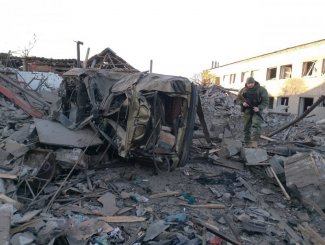Further devastation of Ukraine’s energy system. 286th day of the war

On 5 December, the Russians launched another attack on Ukraine’s energy infrastructure facilities in Kyiv, Odesa and Vinnytsia oblasts were hit. The Ukrainian command reported that out of more than 70 missiles of various types used in the attack, more than 60 were shot down. Most of these were cruise missiles Ch-101/Ch-555 fired from strategic bombers and Kalibr from ships operating in the Black Sea (38 and 22 missiles, respectively). Kyiv reported the highest number of downings, with 9 out of 10 missiles fired.
The attack resulted in emergency power cuts in all Ukrainian oblasts, with the largest in Dnipropetrovsk, Donetsk, Kyiv, Sumy and Zhytomyr oblasts. In the capital, half of the city was deprived of power supply. Odesa, in turn, is completely cut off from electricity, running water and central heating. On 6 December, the state-owned company Ukrenerho announced that it would take several days to restore the state before the attack. Prime Minister Denys Shmyhal reported that Russian strikes had damaged 35% of Ukraine’s power grid facilities, and 70% of them had been attacked at least twice. The energy deficit remains at 19% of its current consumption.
Kramatorsk, Kryvyi Rih and Zaporizhzhia were again the targets of Russian missile and drone attacks. Kherson and Nikopol, as well as the Ochakiv region, are under permanent fire. Russian artillery and aviation also continue to strike Ukrainian army positions and facilities along the contact lines and in border areas. Ukrainian shelling and bombardment, however, is limited to the main combat areas.
Russian forces continue to advance westwards south of Bakhmut. They were stopped near Bila Hora, 10 km east of Kostiantynivka, the main transport hub between Donetsk and Kramatorsk. Fighting continues on the southern outskirts of Bakhmut and north-east of Bakhmut, east of Siversk, north of Avdiivka and west of Donetsk. Ukrainian forces were to counterattack in the Bakhmut area, Vuhledar and on the border of the Donetsk and Zaporizhzhia oblasts. However, the intensity of operations in the Kharkiv and Luhansk oblasts borderlands decreased.
On 5 December, Russian media reported attacks on the Dyagilevo near Ryazan and Engels in the Saratov Oblast strategic aviation airbases. In the former, three people were reportedly killed, and four were wounded due to a fuel tank explosion. In the latter, two Tu-95MS heavy bombers have been damaged. The Russian defence ministry reported that this occurred due to Ukrainian drone strikes. A day later, on 6 December, Russian local authorities reported that a Ukrainian drone strike on Kursk airport had resulted in a fuel depot fire, as confirmed by publicised satellite images.
On 5 December, the Ukrainian General Staff reported that the combat readiness test of the armed forces there had been extended in Belarus until 12 December. It was stressed that there were still no signs of enemy strike groups forming in the Volyn and Polesie directions. On 6 December, soldiers of the units of the Western Military District of the Russian Federation, part of the Belarusian-Russian Regional Army Grouping, continued tactical training. As part of it, a small town’s pacification (‘cleansing’) was rehearsed on one of the Belarusian training grounds, and the scenario included blockade actions. The training included an artillery barrage, after which the town was seized and prepared for defence. In response to the training activity on the Belarusian side, the Ukrainian Armed Forces conducted a staff training exercise near the border on 6 December, with the participation of, among others, the 120th Territorial Defence Brigade.
On 5 December, the commander of the Ukrainian Land Forces, General Oleksandr Syrskyi, presented information on the results of the so-called partial mobilisation in Russia and the aggressor’s objectives. A total of 310,000 soldiers were to be recruited, enabling the Russian army to restore the combat capability lost in earlier operations. As a result, the threat to Ukrainian troops increased. So far, the Ukrainian side has been formulating a message about the low value of the newly mobilised Russian soldiers. However, the level of training of those now being sent into combat is, according to Syrskyi, higher than those who were sent to the front in the early stages of the war.
On 6 December, Ukraine’s Defence Minister Oleksii Reznikov asserted that for the time being, there is no need to start additional mobilisation. According to him, Ukrainian forces have sufficient manpower in the security sector as well. He admitted that the biggest problem remains the insufficient artillery weapons, ammunition, armoured vehicles, tanks and aircraft. Referring to a public petition submitted to the Office of the President regarding the relaxation of the mobilisation regime, he assessed that this would lower the state’s defence capabilities. In addition, Reznikov expressed his conviction that the supply of tanks and combat aircraft from the west would be realised while requiring the implementation of technological and logistical solutions. Speaking about the prospects of Ukraine receiving Patriot air defence systems, he pointed out that they are complex, expensive and take a long time to produce. In turn, Foreign Minister Dmytro Kuleba conveyed that the Ukrainian side is intensively seeking the delivery of US tanks and Patriot systems but that the talks will be time-consuming.
On 6 December, the State Border Service of Ukraine indicated that Belarusian services deliberately attempted to smuggle migrants from Iran and Pakistan to identify insufficiently protected border sections with Ukraine. The information gathered can be used to plan military operations. Similar activity has been observed on the border with Latvia. At the end of November, a group of illegal migrants from Southeast Asia, escorted by Belarusian border guards, was detained on the northern border of Ukraine. The Ukrainian side reiterated that it was counting on the possibility of a stream of migrants being diverted to Ukraine in operation controlled by Belarusian services.
An atmosphere of the threat of attack by Ukrainian forces is being stoked in Russia. The governor of the Belgorod Oblast announced the formation of several ‘territorial defence’ battalions to be deployed in the border area. He had previously reported that the threat of Ukrainian forces entering and encircling Belgorod was real.
Commentary
- The eighth massive Russian missile attack on the Ukrainian energy system since the beginning of October has confirmed that a strike on a few suitably selected sites is sufficient to cause a partial blackout across Ukraine. After 15 November, the Russians used fewer missiles and drones for each successive attack and reduced the number of targets. Nevertheless, they are achieving a comparable effect, i.e. leading to emergency power outages lasting up to several days in most oblasts. Nevertheless, even without renewed attacks, the Ukrainian energy system has been compromised to the extent of forcing daily power outages lasting several hours. After the 23 November strike, Ukrainians estimated that restoring regular and comprehensive system operation would not be possible until spring 2023. However, each subsequent Russian attack moves this prospect further away.
- The reliability of Russian information about attacks on strategic aviation bases remains an open question. Only the fire in the Kursk airport area can be confirmed based on the available satellite images. It should be noted that a few hours after Moscow’s publicised reports of the attack, aircraft from the Engels base participated as the core of the Russian grouping in striking the Ukrainian energy infrastructure. Kyiv has so far failed to take a position on the issue, with the Americans declaring that they have not and will not supply Ukraine with armaments to attack sites deep inside Russian territory.
- The Belgorod governor’s initiative to create ‘volunteer’ battalions shows that, despite the official end of the so-called ‘partial mobilisation’, the Russian authorities are looking for solutions to continue it unofficially. In addition to the military dimension, which is the already declared intention to build fortifications on the border with Ukraine, these measures are intended to discipline society. The authorities’ underlining the threat of an offensive is an effort to justify the need for further aggression against Ukraine and to involve the civilian population in supporting the armed forces.




